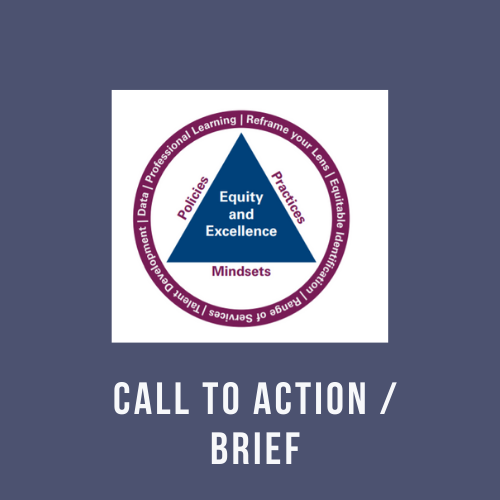Increasing Equity
This page is under construction. Many more resources are being added to reflect the work being done to synergize efforts toward academic success for all students.
Call to Action

Access the complete brief here.
Critical Actions to Realize Equity and Excellence in Gifted Education Changing Mindsets, Policies, and Practices
Increase access and opportunities to increase achievement and growth for all
In gifted education, we seek to meet the advanced learning needs of students all day, every day. However, inequities rooted in larger society plague education, often leading to inequitable representation in gifted programs.
Although schools cannot fix larger societal inequities on their own, we can ensure that our actions do not compound these inequities. Our goal must be to promote both equity and excellence. We must take actions to increase access and opportunity, which increases achievement and growth for all. We must assure that student racial, ethnic, economic, or other demographic factors do not reduce their likelihood of access and successful participation in advanced programming. By realizing equity and excellence in gifted education, schools will help all students reach their full potential.
Critical Actions to Realize Equity and Excellence in Gifted Education
Changing Mindsets, Policies and Practices
To set the foundation for realizing both equity and excellence, we must approach it from the shared perspective that both can be realized. Both are integral to a successful educational environment. This commitment toward equity and excellence is urgent and requires intentional and sustained actions. No single action will change mindsets, policies, and practices; we must synergise efforts to increase achievement and growth for all.
Action 1: Reframe your Lens
We must reframe our lens on how we view students, their actions and beliefs; how we view schools, our actions and goals; and how we view ourselves, our roles and responsibilities.
How? Reflect on our own biases, stories, and influence. Connect with student experiences. View students as "at-potential" versus "at-risk."* Be a talent scout not a deficit detector. Look for opportunities to say yes, not opportunities to say no.
Why? By reframing our lens, we ensure that all students have an equitable opportunity to access gifted programs. We begin to change our mindsets, raise expectations, and begin the pathway toward equity and excellence.
What is Equity and Excellence in Gifted Education? What is it not?
It is not about 'status' or sacrificing needs of one group of students for another; it is meeting the needs of all students.
It is not seeing students at-risk; it is seeing students at-potential.*
It is not having multiple hoops to show a student's perfection in everything; it is about multiple opportunities for students to demonstrate their
